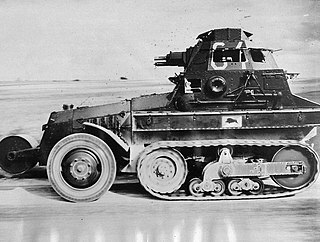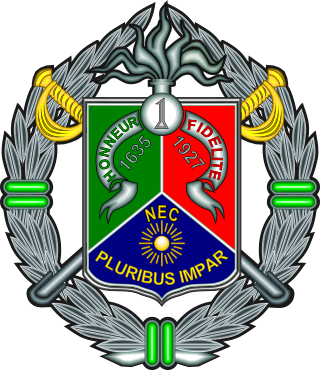
The 10th Panzer Division was an armoured division in the German Army, the Heer, during World War II, established in March 1939.

The AMC Schneider P 16, also known as the AMC Citroën-Kégresse Modèle 1929 or the Panhard-Schneider P16, was a half-track that was designed for the French Army before World War II.

The 1st Foreign Cavalry Regiment is the only cavalry regiment of the Foreign Legion in the French Army. It is one of two armoured cavalry regiments of the 6th Light Armoured Brigade.

The Foreign Legion has had a long and unique history amongst the units of the French Army. It was historically formed of expatriate enlisted personnel led by French officers. Founded by a royal ordinance issued by King Louis Philippe of France on March 9, 1831, with the aim of bolstering the strength of the French Army while also finding a use for the influx of refugees inundating France at the time. The Foreign Legion subsequently found a permanent home in the ranks of the French military. The Foreign Legion's history spans across the Conquest of Algeria, the Franco-Prussian War, numerous colonial exploits, both World Wars, the First Indochina War, and the Algerian War.
The 19th Army Corps was a corps of the French army. In December 1870, the Tours delegation created the 19th Army Corps which was formed in Alençon. It was recreated by decree of the JO of August 13, 1874, it brought together the various military units of Algeria. It constituted the nucleus of the Army of Africa.

The 1st Free French Division was one of the principal units of the Free French Forces (FFL) during World War II, renowned for having fought the Battle of Bir Hakeim.

The Foreign Legion Detachment in Mayotte is a detachment of the Foreign Legion based on the island of Mayotte, near Madagascar. It is the smallest operational unit of the French Army. The main role of the detachment is to maintain a French presence in the region, enabling the French armed forces to quickly react to events in the Indian Ocean and the east coast of Africa.

The 2nd Foreign Cavalry Regiment was a cavalry regiment of the Foreign Legion in the French Army. the regiment was dissolved twice, in 1946 and 1962; the regimental colors have been entrusted to the Foreign Legion Detachment in Mayotte since 1984.

The 6th Foreign Infantry Regiment was an infantry regiment of the Foreign Legion in the French Army from 1939 to 1941 and again from 1949 to 1955.
Paul Lacombe de La Tour was a French army officer who served from 1910 to 1940 through both World War I and World War II. He eventually rose to the rank of lieutenant-colonel and led the 97th Reconnaissance Group of the Infantry Division into combat during the Battle of France. La Tour was killed in action while commanding a rear guard action which was covering the withdrawal of the 7th North African Infantry Division across the Oise River.
The 7th Infantry Division North African was an infantry division of the French Army that participated in the Second World War.

12th Infantry Division was an infantry division of the French Army which took part in the Napoleonic Wars, World War I and World War II. It fought at the Battle of the Nations in 1813. It was converted to a motorised infantry role at Mourmelon-le-Grand in 1939 a few days before the French declaration of war on Germany and renamed 12th Motorised Infantry Division
The Groupes Franc Motorisé de Cavalerie or GFC was a type of autonomous unit of the French Army created during the Nazi Invasion. Taking inspiration for their name from the Corps Francs which had played an important role in the Phoney War, they were a very early attempt to create truly independent Combined Arms Combat Teams. Although little more than Company sized, they had organic Armored, Artillery, and Infantry elements all rolled into one small and highly mobile force. They were created somewhat out of desperation in response to the rapid German advance into France and operated as independent strike forces with great latitude of movement. Although they were found to be quite effective, their existence died with the Third Republic.

The 15th Infantry Division was an infantry division of the French Army originally formed after the end of the Franco-Prussian War that fought in World War I. It fought in World War II as the 15th Motorized Infantry Division, under the command of Alphonse Juin, surrendering during the Battle of France.

The Regiment "Nizza Cavalleria" (1st) is a cavalry unit of the Italian Army based in Bellinzago Novarese in Piedmont. The regiment is the reconnaissance unit of the Alpine Brigade "Taurinense". The regiment is named for the County of Nice in France, which makes the regiment, along with the Regiment "Savoia Cavalleria" (3rd), one of two Italian Army units named for a French region, which once was part of the Kingdom of Sardinia.

The Regiment "Savoia Cavalleria" (3rd) is a cavalry unit of the Italian Army based in Grosseto in Tuscany. The regiment is the reconnaissance unit of the Paratroopers Brigade "Folgore". The regiment is named for the Duchy of Savoy in France, which makes the regiment, along with the Regiment "Nizza Cavalleria" (1st), one of two Italian Army units named for a French region, which once was part of the Kingdom of Sardinia.

The Regiment "Lancieri di Aosta" (6th) is a cavalry unit of the Italian Army based in Palermo in Sicily. The regiment is the reconnaissance unit of the Mechanized Brigade "Aosta". The regiment was formed in 1774 as present to the King of Sardinia's fifteen-year-old son Victor Emmanuel, Duke of Aosta. The regiment fought in the War of the First Coalition against French forces, until 1796 when Napoleon Bonaparte defeated the Royal Sardinian Army in the Montenotte campaign. In October of the same year the regiment was disbanded.
The 183rdInfantry Division of Africa was a unit of the French Army formed in Algeria during the French colonial period at the beginning of World War II.













